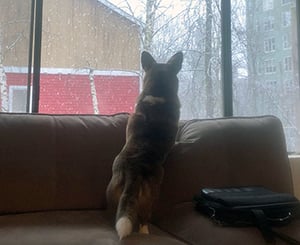
Does your dog have to let you know about any and every person or animal that passes by your home? Does your dog bark at strangers?
There are many reasons a dog barks, and we call this kind of barking "alert" or territorial barking – something that we humans originally preferred dogs to do, and we bred for it in the domestication process.
I personally prefer that my dog bark once or twice to let me know that someone is approaching my door.
However, alert barking becomes a nuisance when your dog is constantly reacting to everyone they see or hear walking by your home.
Many apartment dwellers deal with alert barking (and frustrated neighbors) when their dog barks any time someone passes by their door, gets out of the elevator, or closes their own apartment door. The proximity of all the noises can be tough in an apartment setting for a dog. In this article, we’ll talk about what you can do to teach your dog not to bark at people or things they hear passing by or see through the window.
Table of Contents
Why Do Dogs Bark Out the Window?
There are a few different reasons dogs will bark besides alerting to someone or something outside. It could be due to boredom, anxiety, fearful reactivity, or they’ve learned that barking gets them attention (even if this is just you yelling at them to stop), which is called "demand" barking.
To read more about the different types of barking, check out our article "Why Your Dog Is Barking and How to Stop It."
First, you have to figure out what is causing your dog to bark, which then determines how to approach this problem behavior. A certified dog trainer can help you determine the trigger for your dog's barking if it isn't immediately obvious, and a wifi-enabled pet cam can also help. The most useful one for barking dogs is the Furbo Dog Camera. It will send alerts to your smartphone when it detects barking, has two-way audio so you can get your dog's attention, and has a fun treat-tossing option that can be pre-programmed or done directly from the app.
Alert and territorial barking is a normal dog behavior. Plus, it's very reinforcing for your dog.
Just imagine what they're thinking: "I barked to tell that person to go away, and it worked! I've got to do that again next time!" Your dog doesn't understand that the person was going to pass on by whether they barked or not.
Does this sound like your dog? Read on for tips on how to teach them to be quiet instead.
How to Stop Your Dog From Barking All of the Time
Manage Your Dog's Environment to Prevent Barking
I had a training client who had a sweet little terrier mix named Annabella, and they lived in a house along a waterfront path in our town that was always busy with foot traffic. The front window looked directly out at all of the people passing by, and Annabella's owner was at her wit's end. Annabella barked incessantly at everyone who walked past the house, and the neighbors were starting to complain.
I arrived at our first training session and watched as Annabella took her usual place: perched on the back of the sofa next to the front window. This dog was ready to rock, ears forward and eyes scanning for the next walker to pass by. And sure enough, a postal worker meandered by, and Annabella proceeded to let the entire neighborhood know that something was afoot!
Do you want to know how we solved Annabella’s alert barking in just one easy step? We moved the couch.
Annabella’s trigger for barking was seeing someone walk past on the sidewalk outside her home. By moving the couch so she couldn’t use it as a way to see out the window, we removed her trigger for barking. Now, this was an easy solution because Annabella was a small dog that couldn’t see out the window without some help from furniture, but there are other ways to change your dog’s environment to remove visual triggers for barking:

- Close the blinds or draw the curtains.
- Install privacy film on your windows (either the entire window or only enough height to block your dog’s view outside). There are different colors and patterns available, like this Non-Adhesive Decorative Window Film by Rabbitgoo.
- Pro Tip: You can do an easy DIY version of window film with bubble wrap. Cut the bubble wrap to the size you need, lightly spray the window with water, and apply the bubble wrap to the window with the flat side down. It should stick, and when you're ready to remove it, simply pull it off.
- Pro Tip: You can do an easy DIY version of window film with bubble wrap. Cut the bubble wrap to the size you need, lightly spray the window with water, and apply the bubble wrap to the window with the flat side down. It should stick, and when you're ready to remove it, simply pull it off.
- When you aren't home, keep your dog in an area without a view of the street outside. Consider using a crate if your dog is happily crate trained, or use a gate to block off access to rooms with the windows they bark at. Setting up a long-term confinement area is another great option for managing your dog's space.
- You can help keep your dog's brain occupied (and not barking) while you're away with interactive dog puzzles and toys, like a stuffed Kong.
- Turn on music, a fan, or a white noise machine to mask outside sounds that may trigger your dog's barking. Whenever I leave my house, I turn on DogTV to provide some visual enrichment and calming background music.
For many dog owners, simply removing the visual or sound trigger for barking is enough. However, if you do want to be able to leave your curtains open or blinds up, you'll need to pair this step with teaching your dog not to bark at things going by the window, which you'll learn how to do in the section below.
Whenever you are unable to work on training at the window, you want to make sure to block any visual stimulus so your dog doesn't have the opportunity to bark at the window. The more they practice the barking behavior, the more reinforcing it becomes for them and the more difficult it is to change.
Countercondition and Desensitize Your Dog's Barking Trigger
You can teach your dog an alternative reaction to the thing that originally caused barking, which is called the "trigger" for the behavior. You'll be desensitizing them to seeing or hearing someone walk by.
When I first moved into my apartment with my dog, she would bark at every sound she heard outside, from a car door slamming to someone walking past our door. With some practice, however, she now only barks when someone is actually knocking on our door. Follow these steps to help your dog habituate to their barking triggers:
If Your Dog Barks When They See Things (people and/or pets walking by, postal workers, birds in the yard, etc.):
I love using the Open-Bar Closed-Bar method for counterconditioning a dog's visual barking trigger.
- Stock up on some high-value training treats like these Freeze-Dried Raw Treats from Northwest Naturals. Remove the window film or bubble wrap from the window, or open the blinds or curtains. Your dog will need to be able to see their usual barking trigger.
- As soon as your dog notices someone about to walk by, and BEFORE they bark, give them treats, one after another, until the person is out of their sight again.
When the trigger is in sight = the treat bar is open! When the trigger is out of sight = the treat bar is closed. - This is changing your dog's conditioned emotional response to seeing someone walk by. Before, they would bark in an effort to make it go away. Now they're learning that the good stuff only happens when the trigger is present, once it leaves the fun stuff stops.
- You'll notice with a few repetitions that when your dog sees the trigger, they'll choose to disengage and look to you for a reward. Progress!
- Once you see your dog choose to disengage, change the timing of the treats to when they look at you after noticing their trigger.
- With practice and consistency, you'll see a reduction in your dog's alert barking.
Watch this video example of how to use the Open-Bar Closed-Bar training method for barking at the window:
If Your Dog Barks at Noises (cars beeping, car doors slamming, neighbor’s door opening or closing, barking dogs, etc.):
While you help your dog learn not to bark at noises they hear outside, consider masking outside noise with a fan or by playing calming music or an audiobook, especially when you aren't home to work on the training outlined below.
- Be prepared with some tasty treats. Wear a treat pouch while you’re at home, or keep a jar of training treats close by.
- When your dog hears their usual trigger and BEFORE they bark, calmly praise and toss them a treat. The timing here can be tough. If you miss the opportunity to capture that quiet moment before they start barking, it’s a great time to practice the Quiet cue (which is explained below in this article).
- What this process is doing is creating an association in your dog’s brain that the sound outside predicts treats falling from the sky and praise from you, as well as reinforcing staying quiet when they hear it.
- As your dog becomes more and more habituated to the outside noise, you can fade out food rewards and simply use praise when needed to reinforce the behavior.
Pro Tip: Calm praise is key – keep your voice at a lower volume and slow when reinforcing with praise in this scenario. You’re encouraging and rewarding calmness, and sometimes when we praise excitedly it makes it hard for a dog to relax and not bark out of excitement.
Now that my dog is habituated to the usual noises outside our apartment, I don’t reward her with food treats unless she’s doing an amazing job at ignoring a loud ruckus outside. She definitely still got some beef liver when she didn’t bark during a neighbor’s party with all the people coming and going throughout the evening, though. It's always best to pay for amazing work!
Teach Your Dog to Be Quiet When Asked
I love taking advantage of a barking dog to teach them how to be quiet when asked. You can't teach one without the other! Use this training technique when your dog has already started barking at the trigger outside.
- Have treats ready, and stand close to your dog. Say "Quiet" in a happy voice. (My verbal cue for my dog is "Thank you!")
- Your dog might look at you when you say the word "Quiet" — if they do, make sure to capture that moment of silence with immediate treats and praise. If you'd like a precise way to tell your dog what's getting them the reward, learn more about clicker training by reading our article An Introduction to Clicker Training.
- Some dogs need help to focus when they're already barking, especially if there's a big distraction outside. Place a treat in your closed fist and place that hand in front of their nose. They'll be able to smell it and will likely stop barking. Once they've stopped barking, say "Quiet," open your hand and give them the treat. Make sure to give them lots of praise!
- If your dog continues to stay quiet, reward again with another treat! If they start barking again, take that opportunity to practice another "Quiet." Pay attention to your treat timing to reward keeping their mouth closed after getting the first treat; don't wait too long before that second or third treat. They'll lose interest in what you have and go back to barking at their trigger.
- With practice, your dog should respond more and more quickly to the verbal cue of "Quiet," and you'll no longer be relying on a hand lure to help them stop barking. This is when you can start waiting to reward with a treat to build the duration of the cue.
- When you say "Quiet," treat if they can keep their mouth closed for 3 seconds. Then, increase the duration to 5 seconds before the treat happens.
- As they get better at responding quickly to the quiet cue and continue to stay quiet for some time after being asked, you can start fading out the use of food rewards. Make sure you still reward them with praise, petting, or some fun toy play when they stop barking when asked.
(Want to learn more about how to stop using food treats? Read my post, Be A Slot Machine: How to Fade Out Treats in Training.)
I highly recommend building a strong foundation of the Quiet cue before trying to practice this around distractions. A wonderful way to train Quiet is to teach it in conjunction with the Speak cue. Watch this Zak George video to see how to train these behaviors together:
Use Existing Training Skills to Your Advantage
Some dogs have great foundational training skills already, and you can use what's already in your training toolkit to your advantage! If your dog reliably responds to their name, you can use their name to interrupt barking instead of a quiet cue.
Or if your dog has an amazing recall away from distractions, call them to come when they start barking. Just make sure it's highly rewarding for them to stop barking when they hear their name or come when called. Reward heavily when first introducing this kind of distraction to an already known cue.
Get help for your dog's barking in our Dog Training Essentials: All About Barking Workshop
Includes self-paced training modules, video demonstrations, and more – all for only $9.
Things to Avoid: Shock collars (also known as bark collars or E-collars), spray collars, or other aversive barking deterrents
While it might seem like an easy fix, using aversive dog training tools like electronic shock collars, citronella spray collars, or ultrasonic bark deterrents is just not worth the risk. Dogs learn by association. If they are barking at someone walking past the window and receive a shock as a punishment, they'll learn that people predict pain or discomfort, and their barking (and possibly even aggression) is likely to become more ingrained and even worse. Is that really what you want to be teaching your dog?
In my experience, many clients who contact me to help with their dog's barking have already tried these kinds of tools. In the case of ultrasonic bark deterrents, many dogs don't find the noise unpleasant enough to stop barking, making the tool useless as a punishment. In the case of shock collars or spray collars, the dog has developed fearful reactivity or aggression towards the trigger — something that is much more difficult to treat than just alert barking.
The methods outlined earlier in this article are better, more humane, and scientifically-based training methods to teach your dog to stop barking. Do yourself and your dog a favor and opt for these methods as opposed to bark collars and other aversive methods. Read more about aversive tools and why they can actually do you and your dog more harm than good in my article Dog Training Aversives: What Are They and Why Should You Avoid Them?
Does your dog bark out the window? Tell us what your dog's trigger is, or let us know if you have any questions in the comments below!






